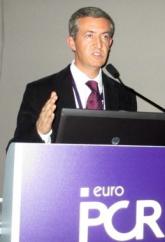News

DESolve Bioresorbable stent speeds coronary healing
Major finding: Patients averaged a 0.21-mm late lumen loss 6 months after receiving a DESolve bioresorbable vascular scaffold.Data source: The...
EXPERT OPINION FROM EUROPCR 2013
"The data indicate at least similar safety and efficacy for BVS as for current drug-eluting stents," said Dr. Dudek, We can start replacing drug-eluting metal stents with BVS in many cases, especially for focal stenoses in younger patients."
But Dr. Chaim Lotan voiced concern about the incidence of low and slow blood flow during and after the ACS procedures. "Reduction of flow predicts mortality," he warned. "I think this is related to the aggressive vessel preparation," said Dr. Lotan, director of the heart institute at Hadassah Medical Center in Jerusalem.
Dr. Dudek acknowledged that the predilatation with a noncompliant balloon that BVS requires can trigger slow or no flow in the infarct vessel.
In response, Dr. Ron Waksman defended the BVS concept. "We see 4% restenosis after 3 years, and 6% after 4 years" with conventional drug-eluting metal stents. "These are unacceptable numbers. BVS is a new technology that guarantees that after 3 years there is no stent," said Dr. Waksman, associate director of cardiology at MedStar Washington Hospital Center.
The Czech STEMI registry
A third European registry of default BVS that began late last year focused on patients treated for ST-elevation MI at a participating center in the Czech Republic during December 2012-May 2013. Of the 87 patients who presented at participating centers with STEMI, 22 patients (25%) met prespecified criteria for undergoing BVS treatment, a BVS penetration level similar to the rate in the Thoraxcenter series. One eligibility criteria was life expectancy of at least 3 years. The 21-treated patients received 27 of 28 BVS successfully; one BVS could not be placed because of vessel tortuosity. Nineteen of the 21-BVS-treated patients achieved TIMI III grade coronary flow after PCI, with the other two patients reaching grade II flow, reported Dr. Petr Widimský, professor and head of the cardiocenter at Charles University in Prague. Common reasons why STEMI patients did not receive a BVS included no stent needed; a vessel too wide (more than 4.0 mm) to be treated by existing BVS sizes; or the presence of pulmonary edema or shock. During follow-up, one patient had a reinfarction caused by BVS thrombosis 3 days after stopping ticagrelor, but no patients had any episodes of clinical restenosis during follow-up of up to 5 months.
Based on the experience so far in three reported programs using BVS to treat patients with STEMI the key for successful use in these patients seems to be treating appropriately-sized coronary arteries because the possibility to post-dilate the BVS without breaking it is limited, said Dr. van Geuns.
Despite limited experience so far using BVS in routine practice, experts see the penetration the devices have made so far as a model for the future of interventional cardiology. During one panel discussion on BVS at the meeting, the widely shared consensus was that within a decade BVS numbers will surpass metallic stents for PCI and truly be the default device, with use in three-quarters or more of PCI patients.
A larger BVS registry
A larger record of BVS performance reported at the meeting came from a registry of 450 patients followed for 1 year after receiving one or two BVS at centers that participated in the ABSORB EXTEND trial. Average lesion length treated was just under 12 mm, and 93% of patients had a single lesion. During 12 months of follow-up, patients had one death, 13 myocardial infarctions, and eight instances of ischemia-driven target-vessel revascularization, for an overall major adverse event rate of 4.2%, reported Dr. Patrick W. Serruys, professor of interventional cardiology at the Thoraxcenter. Four cases of scaffold thrombosis (0.9%) occurred during 1 year follow-up.
Dr. Serruys showed how the BVS outcomes from the 450 patients in this registry compared with a historical series of patients who received the Xience V everolimus-eluting coronary stent in the SPIRIT II (Eurointervention 2007;3:315-20) and SPIRIT III (JAMA 2008:299:1903-13) trials. The 12-month major adverse cardiac events (MACE) rate of 4.2%, scaffold thrombosis rate of 0.9%, and the 2.9% MI rate seen with the Absorb BVS in the registry compared well with the 5.3% MACE rate, 0.7% definite stent thrombosis rate, and 2.3% MI rate seen with Xience V in the two older trials, Dr. Serruys noted. The BVS had no significant safety and efficacy differences, compared with historic results from a drug-eluting, metallic stent comparator, but with the added potential benefit of disappearing from the patient.
High expectations for BVS
"The noninferiority of BVS has been well established in patients with simple [coronary] disease, but in patients with diffuse disease, BVS may well be superior," said Dr. Ibrahim Al-Rashdan, director of the cardiac catheterization laboratory at in Kuwait Heart Center. "We can use BVS to avoid a metal jacket with diffuse disease. But lesion preparation and good vessel sizing is mandatory. And if the vessel is calcified you must use a rotablator; if you have any doubt, use a rotablator." Another limitation of BVS is that because they are made from polymers, they break when overexpanded, and the currently available models are bulkier than metallic stents and their bulkiness demands predilatation of the artery receiving a BVS. "There is consensus to use BVS for long lesions, and for patients with diabetes," said Dr. van Geuns.

Major finding: Patients averaged a 0.21-mm late lumen loss 6 months after receiving a DESolve bioresorbable vascular scaffold.Data source: The...
